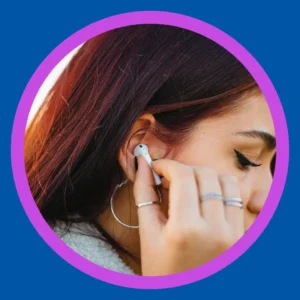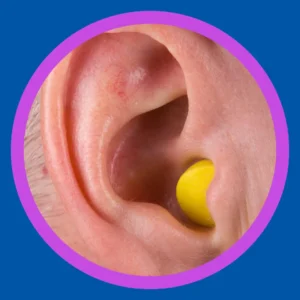Hearing Loss Increases in Millennials and Gen Z
Hearing loss among millennials and Gen Z is more common than most people think. This isn’t a future problem—it’s happening now. In fact, the keyword phrase hearing loss among millennials reflects a growing public health concern. Early intervention is essential to protect long-term hearing health.
Noise-Induced Hearing Loss: A Modern Epidemic
For young people, the main culprit behind hearing loss isn’t aging. It’s exposure to loud noise. A 2019 study in PNAS found that over half of adults in their 20s had difficulty understanding speech in noisy environments. Most of those affected had extended high-frequency (EHF) hearing loss—a problem not always detected in basic hearing screenings.
EHF hearing allows people to detect subtle speech cues. Without it, even normal environments become difficult to navigate. This study showed that listening problems start far earlier than previously assumed. Testing for EHF hearing loss could lead to earlier diagnosis and treatment.

How Common Is Unsafe Listening?
Unsafe listening habits have become widespread. A 2022 meta-analysis published in BMJ Global Health estimated that up to 1.35 billion young people are at risk for hearing loss. This includes people ages 12 to 35. The main culprits? Loud concerts and headphones turned up too high.
Personal listening devices often hit 105 decibels. At that volume, hearing damage can happen in less than 15 minutes. Noise levels at events like concerts or clubs often exceed 110 decibels. Even short exposure at that volume can harm your ears.
Learn how to stay safe with hearing loss.
It’s Not Just Temporary
You might think ringing in the ears after a show is temporary. But repeated exposure causes lasting damage. The BMJ article noted that early damage can compound over time, making ears more vulnerable to age-related hearing loss later.
Researchers argue that unsafe listening should be treated as a modifiable risk factor. That means it’s something we can change—with awareness, behavior change, and policy support.
What the Cincinnati Children’s Study Found
A study by Cincinnati Children’s Hospital added to this urgent conversation. Researchers tested over 100 adults ages 20 to 62 with normal hearing. Published in PNAS, the study found that 64% had EHF hearing loss, and over 30% had trouble following speech in background noise.
Surprisingly, even many 20-somethings showed signs of hidden hearing loss. These results suggest that hearing challenges don’t always begin with older adults. Testing for EHF loss and using speech-in-noise tests like the digits-in-noise (DIN) app could help detect problems early.

What the WHO Says About Unsafe Listening
The World Health Organization has warned about the global impact of recreational noise. They estimate that 1.1 billion young people are at risk from unsafe listening practices. That risk includes both device use and exposure at loud venues.
Their guidelines state that 85 decibels over a 40-hour week is the safe limit. But modern lifestyles regularly exceed those limits. The study’s data are now helping inform policy and prevention initiatives.
Signs of Hidden Hearing Loss
Young people often miss the early signs of damage. They may pass basic hearing tests but still struggle. Here are some key warning signs:
- Difficulty following conversation in noise
- Ringing in the ears (tinnitus)
- Turning up devices louder than others prefer
- Feeling fatigued after long conversations or meetings
If any of these apply to you, consider a hearing test with a provider trained in EHF testing.
Why This Matters for Long-Term Health
Hearing loss impacts more than just your ears. A recent report links unaddressed hearing loss with social isolation, reduced income, and even cognitive decline. Starting early with prevention reduces these risks.
Young people with hearing loss often report academic struggles, concentration issues, and lower motivation. These effects can compound and influence future income, career performance, and overall well-being.

How to Protect Your Hearing
You can take steps now to prevent damage. Prevention doesn’t mean sacrificing fun. It means using smart strategies to preserve hearing. Here are the most effective ways to protect your ears:
1. Limit Time in Loud Environments
Avoid staying in noisy places for extended periods. Take breaks every 30 minutes when possible.
2. Use Music Volume Limits
Set your device to max out at 60% of full volume. Most phones offer this feature.
3. Try the 60/60 Rule
Listen at 60% volume for no more than 60 minutes at a time.
4. Wear Hearing Protection
Use foam earplugs, over-ear protectors, or musician’s earplugs when in loud spaces. Musician’s earplugs preserve clarity while reducing volume evenly across frequencies.
5. Get a Hearing Test
Don’t wait. Even if you think your hearing is fine, get tested early. Stanford Hearing can assess EHF hearing and speech-in-noise comprehension.
Find out more about how to prevent hearing loss and reduce its impact.
Let’s End the Stigma
Hearing care isn’t just for seniors. More millennials and Gen Z adults now use hearing aids. Today’s devices are discreet and smart. Many sync with phones and stream music or calls. Addressing hearing early helps preserve social engagement, academic success, and mental health.
At Stanford Hearing, we believe in early intervention. If you’re unsure about your hearing, we can help.
Understand how avoiding hearing tests could make the problem worse.
Check Your Hearing Today
Don’t wait for hearing loss to get worse. Schedule a free hearing evaluation today. Contact Stanford Hearing for personalized care, advanced hearing tests, and support every step of the way.
Protect your hearing —your future self will thank you.
